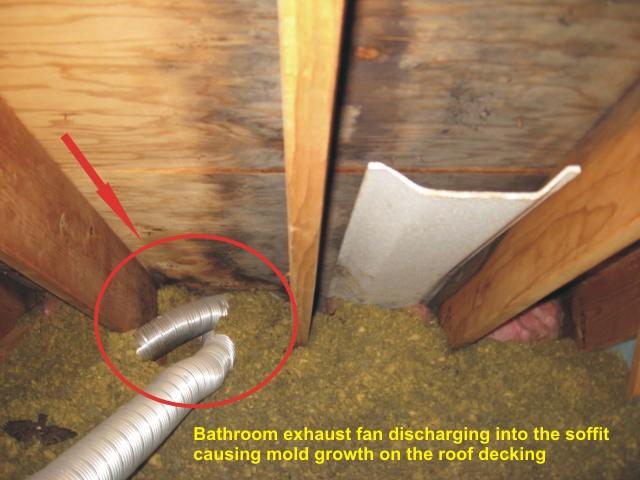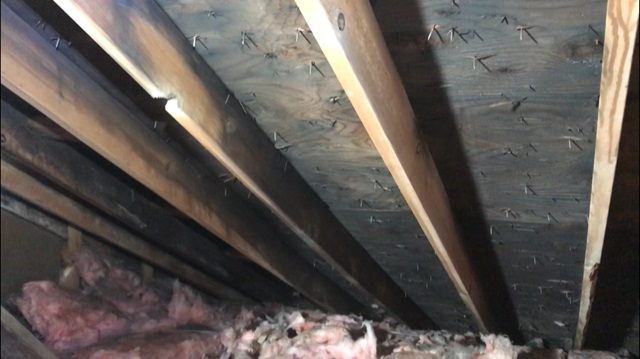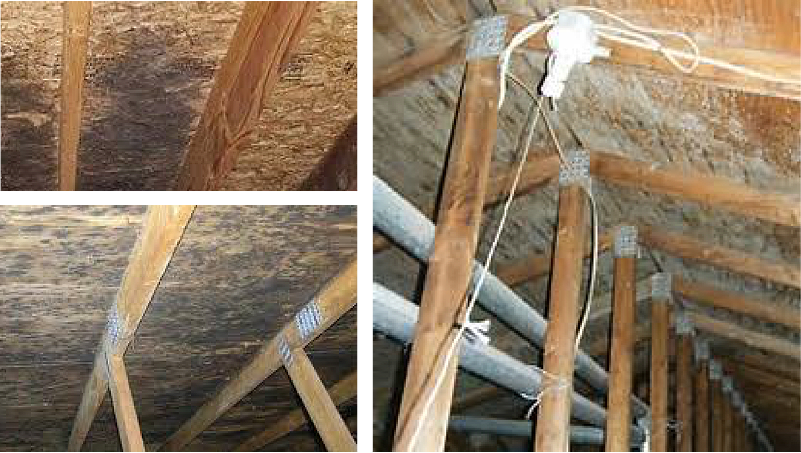Problems with Attic Mold in the
Pittsburgh Area are Extremely Common
Do Any of These Pictures Resemble Your Attic?
If so, click HERE to schedule an appointment or just keep reading. Insulwise’s approach to dealing with attic mold in Pittsburgh is unique from other companies doing this work. Why? Because our solution is building-science based. Sure we kill the mold, but more importantly, we address the root cause — moisture in your attic. Most companies will simply kill the mold and then maybe spray on an additional “mold proof” coating.
Indicators That You May Have an Attic Mold or Moisture Problem:
- Visible black, white, or green splotches on the underside of your roof.
- Visible frost forming on the underside of your roof sheathing.
- Frost or water droplets forming on nail heads.
- A damp, musty, “basementy” type of odor when you go into your attic.
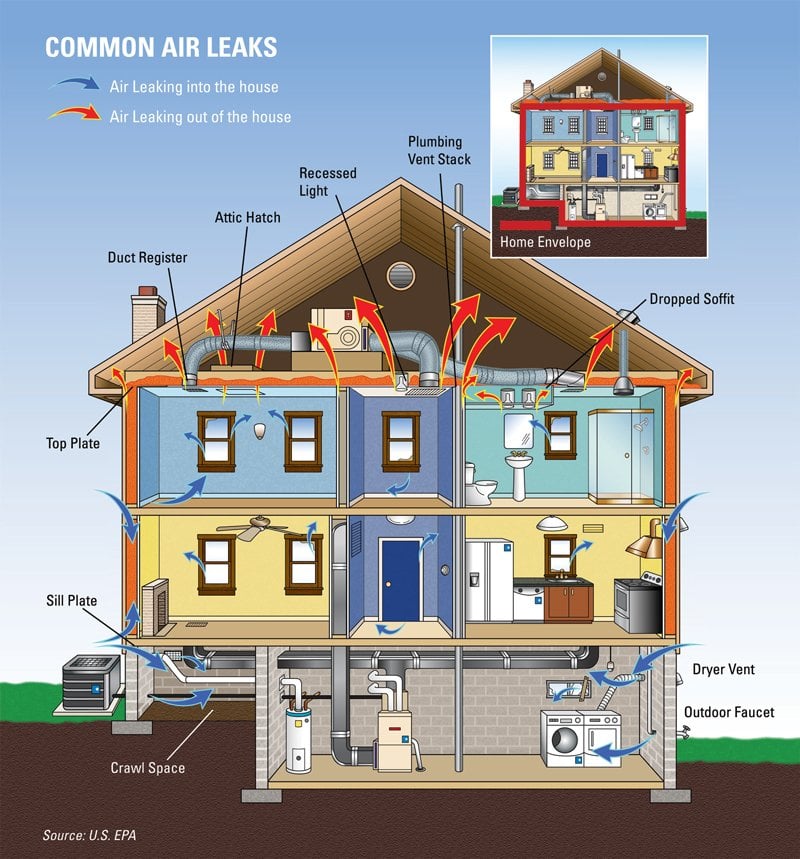
Why Does Mold Form in an Attic in the First Place?
Mold Forms When 3 Things Come Together
- Moisture
- A food source (anything that is organic)
- Temps between 32° – 120° degrees
The key thing here is moisture. Your attic should be dry! For mold to grow in your attic there needs to be a moisture source for it. Sometimes it’s a roof leak. If you suspect that, take a flashlight into your attic while it’s raining. Shine it on the underside of your roof and look for shiny spots. That’s one of the simplest ways to identify a leak. If you believe your roof is sound (and most of the time it is), the moisture is coming from inside your home.
How Do Air Leaks in Your Attic Floor
Promote MOLD Growth in Your Attic?
- Referencing the Common Air Leaks diagram above, air rises during the winter when you heat your home. This is called Stack Effect. When that air escapes upward into your attic via air leaks in your attic floor, it transports the moisture in your home with it.
- When that moisture-laden air then makes contact with the underside of a cold roof — BAM—it condenses!
- At this point the underside of the roof will often become damp. Homeowners can often see frost in their attics, feel that the underside of the roof is physically wet, or detect the smell of “mustiness” (which is literally your roof rotting).
- When the underside of the roof remains continually damp, the conditions are perfect for attic mold growth to start.

Where Does the Moisture in Your Home Come From? A Variety of Sources, But These are Some of the Biggest:
- The humidifier on your furnace. This a MAJOR moisture source. Your indoor humidity level during the winter should only be 30-40%, but some homeowners crank it up to well above 50%. That excess moisture will LIKELY end up in your attic, where it can quickly lead to mold growth on the underside of the roof of your Pittsburgh area home.
- Moisture getting into your basement from wet soil surrounding your foundation. This caused by improper drainage.
- People and pets breathing and exhaling moisture.
- Washing clothes and dishes.
- Taking showers & cooking.
What is Insulwise’s Solution to Attic Mold?

1) First, We Eliminate the Source of the Moisture!
This should be obvious, but MOST mold companies only kill the visible mold, and then maybe spray a coating on the wood afterward.
Our solution is better because it eliminates the ability for mold to grow in the first place.
How do we do this?
- Make sure all bathroom fans are vented properly to the outside.
- Air seal your attic floor. This involves sealing all air leaks with foam and weather-stripping your attic hatch. See our Air Leak Sealing page to better understand this process.
- Watch our Attic Mold Solution video to see exactly how we do this!
Remember — Mold is the Symptom. The Real Problem is Moisture.

2) Maximize Existing Ventilation and Install New Vents When Needed
Whether your attic has gable vents, a ridge vent, soffit vents, a power fan, slant back vents, or a combination of these, we will work to make sure that your attic is venting as well as it can.
How do we do this?
- Install or replace soffit baffles if your home has soffit vents.
- Install additional slant back vents if more ventilation is needed.
- Make sure that gable vents are open and functioning properly.
- IMPORTANT. Many of the attics that we see in the Pittsburgh area with mold problems have IMPROPERLY functioning ventilation. This can exacerbate wintertime Stack Effect, causing more warm, moist air to be brought upward into the attic from the home during the winter. We fix this.
3) Kill the Existing Mold and Eliminate the Mold Stains.
 Insulwise uses a commercial strength, highly effective solution that not only kills the mold that is present but also eliminates the mold stains. Watch our attic mold spray video to see how this is done!
Insulwise uses a commercial strength, highly effective solution that not only kills the mold that is present but also eliminates the mold stains. Watch our attic mold spray video to see how this is done!
Eliminating mold stains is important because if you ever sell your home, you don’t want a home inspector to see them and think you still have a mold problem.
When Insulwise is finished, the underside of your roof will look virtually new!
This is the same roof after being treated. You can also see how the Insulwise team installed soffit baffles to assist with ventilation. These are visible at the bottom of the picture.
The plywood looks almost NEW. And this is starting from plywood that was almost completely black with mold. Watch our short video to really see what this roof looked like when we were finished!
Due to our process of addressing the moisture source AND the mold in these Pittsburgh attics, these homeowners will never need to worry about the mold coming back.
If you suspect you have a mold problem in your Pittsburgh area attic, Call Insulwise at 412-260-6701. We’ll fix it for you — Permanently!
Two Other Risk Factors in Attic Mold Growth
Ventilation Plays a Role, But Perhaps Not the Way You Think. And Likely Not the Way Your Roofer Thinks Either (from our experience).
The Mixed Bag of Attic Ventilation – Insulwise’s Opinion
1) Generally, we prefer More ventilation to Less. With one exception: installing ridge vents on homes that Do Not Have Soffit Vents. Why? Because ridge vents are designed to work with a source of “intake air.”
When there are no soffit vents to provide intake air, a ridge vent can “depressurize” an attic, particularly during the winter.
This exacerbates the natural Stack Effect that is already occurring in homes. The increased air leakage into the attic during the winter (when Stack Effect is strongest) results in more moisture getting deposited into the attic from the home below. This increases mold risk in your Pittsburgh home.
We have seen many attics in the past 10 years that never had a mold problem — until a new roof was put on and a ridge vent was installed. The homes that developed mold problems following ridge vent installation almost never have soffit vents.
By the way, you’ll never hear a roofer or shingle company say this.
 This is how a ridge vent is designed to work. With air intake coming in at the soffit vents [6]. When ridge vents are installed on homes that do not have soffit vents, we often see mold problems.
This is how a ridge vent is designed to work. With air intake coming in at the soffit vents [6]. When ridge vents are installed on homes that do not have soffit vents, we often see mold problems.
They simply allow more air to be pulled upward from the home than before, bring- ing extra moisture with it.
In homes without soffit vents, we prefer maintaining the existing gable vents that most of these homes were built with. Or, add soffit ventilation.
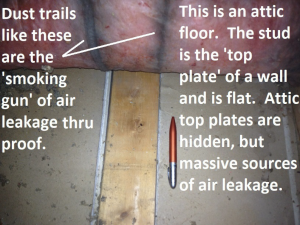
2) Adding insulation to an attic without air sealing it first massively adds to the risk of developing a mold problem.
Why is this? When you insulate, you block conductive heat transfer from your home to your attic. This makes your home more energy-efficient, but you have also:
- Made your attic colder because you’ve blocked heat transfer that was previously warming it.
- However, because insulation Does Not Block Air Leakage you still have the same amount of moisture transfer from your home to your attic.
- This moisture is now Much More Likely to Condense on the underside of your roof — Because your roof is now much colder.
The moral of the story is this. If you are looking to have your attic insulated, make sure your contractor understands that it NEEDS to first be air sealed, and air sealed well!
See our google review from William Simone to see what happened when the insulation company he first hired didn’t air seal before insulating. Disaster! Beneath the picture of me on Insulwise’s google landing page, click on the Google Reviews tab. Then scroll down until you see the review from William Simone that is titled “Insulwise to the Rescue!”

 Two Story Colonial Home
Two Story Colonial Home 1950’s Ranch Style Home
1950’s Ranch Style Home Two Story Contemporary Home
Two Story Contemporary Home Modern Patio Home
Modern Patio Home Three Story Home
Three Story Home Cape Cod Home
Cape Cod Home Attic Insulation
Attic Insulation Floor Insulation (Garage Ceiling)
Floor Insulation (Garage Ceiling) Wall Insulation
Wall Insulation Basement Insulation
Basement Insulation Air Leak Sealing
Air Leak Sealing